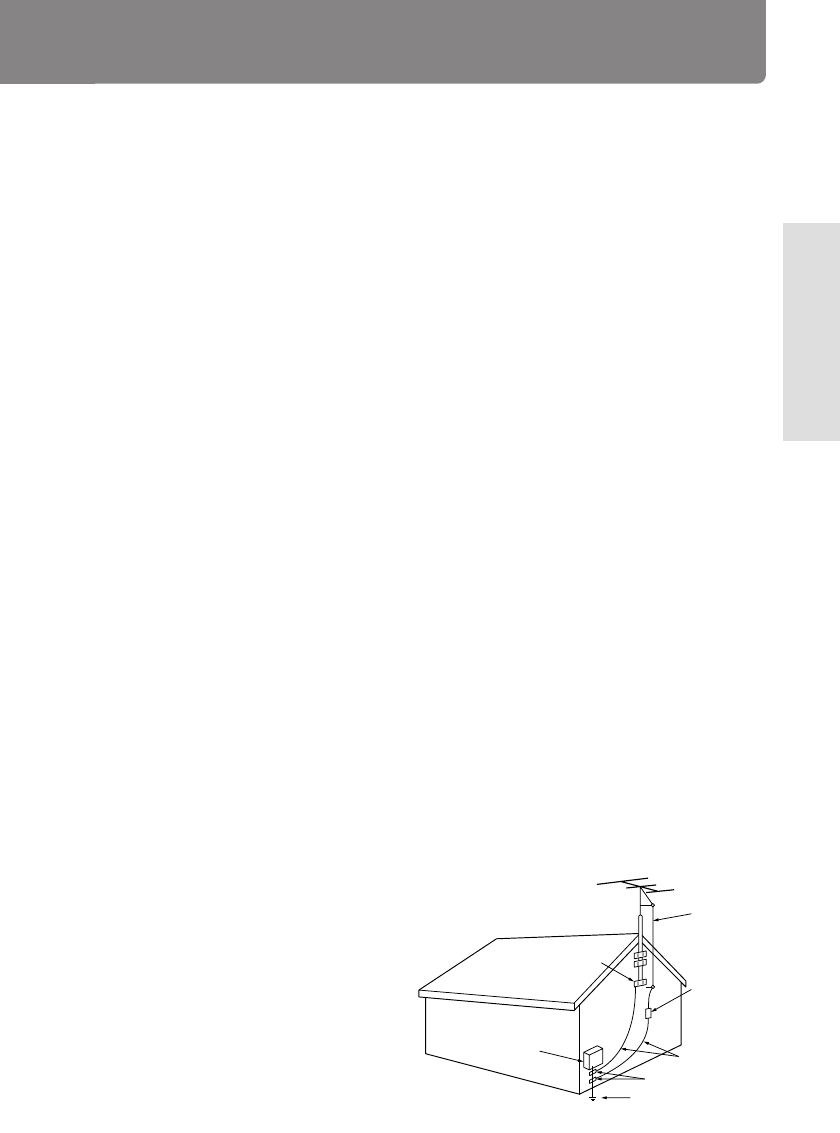
3
Before Using
Connections Other Information
Operation
Important Safeguards
7. Wall or Ceiling Mounting – The appliance
should be mounted to a wall or ceiling only
as recommended by the manufacturer.
8. Ventilation – The appliance should be
situated so that its location or position does
not interfere with its proper ventilation. For
example, the appliance should not be situated
on a bed, sofa, rug, or similar surface that
may block the ventilation openings; or if
placed in a built-in installation, such as a
bookcase or cabinet that may impede the flow
of air through the ventilation openings, there
should be free space of at least 5 cm (2 in.)
and an opening behind the appliance.
9. Heat – The appliance should be situated away
from heat sources such as radiators, heat
registers, stoves, or other appliances (including
amplifiers) that produce heat.
10. Power Sources –␣ The appliance should be
connected to a power supply only of the type
described in the operating instructions or as
marked on the appliance.
11. Polarization – If the appliance is provided
with a polarized plug having one blade wider
than the other, please read the following
information: The polarization of the plug is a
safety feature. The polarized plug will only fit
the outlet one way. If the plug does not fit
fully into the outlet, try reversing it. If there is
still trouble, the user should seek the services
of a qualified electrician. Under no
circumstances should the user attempt to
defeat the polarization of the plug.
12. Power-Cord Protection – Power-supply
cords should be routed so that they are not
likely to be walked on or pinched by items
placed upon or against them, especially near
plugs, convenience receptacles, and the point
where they exit from the appliance.
13. Cleaning – The appliance should be cleaned
only as recommended by the manufacturer.
14. Power Lines – An outdoor antenna should
be located away from power lines.
15. Nonuse Periods – The power cord of the
appliance should be unplugged from the outlet
when left unused for a long period of time.
16. Object and Liquid Entry – Care should be
taken so that objects do not fall and liquids
are not spilled into the enclosure through
openings.
17. Damage Requiring Service – The appliance
should be serviced by qualified service
personnel when:
A. The power-supply cord or the plug has
been damaged; or
B. Objects have fallen, or liquid has been
spilled into the appliance; or
C. The appliance has been exposed to rain;
or
D. The appliance does not appear to operate
normally or exhibits a marked change in
performance; or
E. The appliance has been dropped, or the
enclosure damaged.
18. Servicing – The user should not attempt to
service the appliance beyond that described
in the operating instructions. All other
servicing should be referred to qualified
service personnel.
19. Outdoor Antenna Grounding – If an
outside antenna is connected to the receiver,
be sure the antenna system is grounded so
as to provide some protection against voltage
surges and built up static charges. Article 810
of the National Electrical Code, ANSI/NFPA 70,
provides information with regard to proper
grounding of the mast and supporting
structure, grounding of the lead-in wire to an
antenna-discharge unit, size of grounding
conductors, location of antenna-discharge
unit, connection to grounding electrodes, and
requirements for the grounding electrode. See
Figure 1.
FIGURE 1:
EXAMPLE OF ANTENNA GROUNDING AS PER
NATIONAL ELECTRICAL CODE
ANTENNA
DISCHARGE UNIT
(NEC SECTION 810-20)
GROUNDING CONDUCTORS
(NEC SECTION 810-21)
GROUND CLAMPS
POWER SERVICE GROUNDING
ELECTRODE SYSTEM
(NEC ART 250, PART H)
NEC – NATIONAL ELECTRICAL CODE
ELECTRIC
SERVICE
EQUIPMENT
GROUND
CLAMP
ANTENNA
LEAD IN
WIRE
S2898A


















